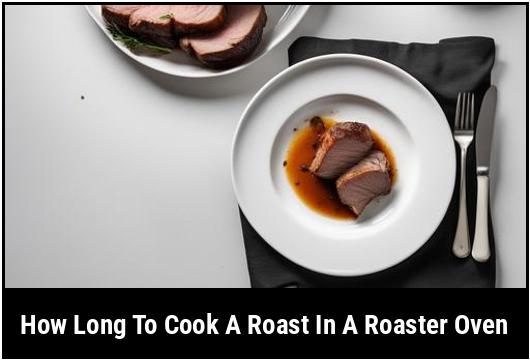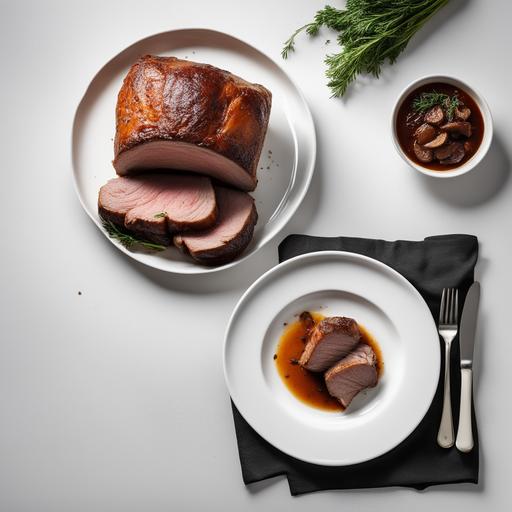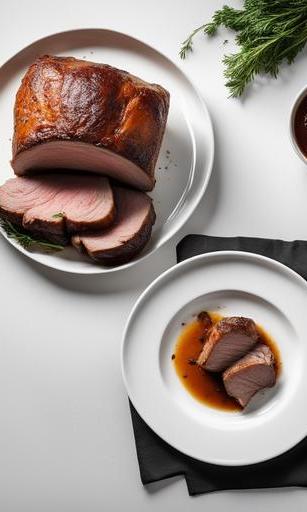[GUIDE] How Long To Cook A Roast In A Roaster Oven

Cooking a roast in a roaster oven is an excellent way to prepare a delicious and juicy meal for your family or guests. Roaster ovens are designed to cook meat thoroughly and evenly, making them an ideal option for cooking roasts. However, determining the cooking time for a roast in a roaster oven can be a bit tricky, as it depends on several factors such as the size and type of roast, the desired level of doneness, and the cooking temperature. In this article, we will provide you with detailed instructions and tips on how long to cook a roast in a roaster oven to achieve the perfect result every time.
Quick Answer: How Long To Cook A Roast In A Roaster Oven
The cooking time for a roast in a roaster oven varies depending on the size and cut of the meat, as well as the desired level of doneness. As a general guideline, you can expect to cook a roast for approximately 20 to 30 minutes per pound. However, it’s always best to use a meat thermometer to determine the exact doneness of your roast. For medium-rare, the internal temperature should be around 135°F (57°C), for medium, it should be around 145°F (63°C), and for well-done, it should be around 160°F (71°C). Keep in mind that these temperatures may vary slightly based on personal preference and the specific cut of meat.
Key Takeaways
- The cooking time for a roast in a roaster oven depends on the size and type of roast, desired level of doneness, and cooking temperature.
- Use a meat thermometer to ensure the roast is cooked to the desired internal temperature.
- It’s best to let the roast rest for a few minutes after cooking before slicing to allow the juices to redistribute throughout the meat.
- Experiment with different cooking techniques and seasonings to enhance the flavor of your roast.
The Science Of Cooking Roast

Cooking a roast to perfection requires an understanding of the science behind the process. When a roast is cooked, the proteins in the meat denature and coagulate, resulting in changes in texture and flavor. The heat also causes the connective tissues in the meat to break down, making the roast tender and juicy.
The internal temperature of the roast is crucial for achieving the desired level of doneness. Different cuts of meat have different ideal temperatures for doneness. For example, a beef tenderloin is best served medium-rare, while a tougher cut of beef, like a chuck roast, benefits from a longer cooking time and is often cooked to well-done.
Choosing A Roast
The type of roast you choose will significantly impact the cooking time and method. Here are some popular cuts of roast:
- Beef Roast: Some popular cuts of beef roast include prime rib, ribeye roast, beef tenderloin, top sirloin, or chuck roast.
- Pork Roast: Pork loin, pork shoulder, or pork tenderloin are common choices for a pork roast.
- Lamb Roast: Leg of lamb or lamb shoulder are common cuts for a lamb roast.
Consider factors like taste preference, tenderness, and budget when selecting a roast. Prime rib and beef tenderloin are typically more tender and expensive, while cuts like chuck roast or pork shoulder are more budget-friendly but require longer cooking times to become tender.
Preparing A Roast
Properly preparing the roast before cooking is essential for achieving the best results. Follow these steps to prepare your roast:
- Seasoning: Generously season the roast with salt and pepper or your choice of herbs and spices. Allow the roast to sit at room temperature for about 30 minutes to enhance flavor and promote even cooking.
- Tying: If your roast is not already tied, use kitchen twine to secure it. This process helps maintain the shape of the roast while cooking.
- Trimming: If necessary, trim excess fat from the roast. Leaving a thin layer of fat can add flavor and moisture during the cooking process.
Ideal Cooking Temperature For Roast
The ideal cooking temperature for a roast depends on the desired level of doneness and the cut of meat. Here are some general guidelines:
- Beef Roast: For medium-rare, cook beef roast at 135°F (57°C), for medium, cook at 145°F (63°C), and for well-done, cook at 160°F (71°C).
- Pork Roast: Cook pork roast to a minimum internal temperature of 145°F (63°C).
- Lamb Roast: For medium-rare, cook lamb roast at 135°F (57°C), for medium, cook at 145°F (63°C), and for well-done, cook at 160°F (71°C).
It’s essential to use a meat thermometer to ensure the roast reaches the desired internal temperature. Insert the thermometer into the thickest part of the meat, avoiding any bones or fat. This will give you an accurate reading of the internal temperature.
Roast Cooking Time

The cooking time for a roast in a roaster oven varies based on the weight and type of roast. As a general guideline, you can expect to cook a roast for approximately 20 to 30 minutes per pound. However, it’s crucial to note that the size and thickness of the roast can affect the cooking time.
To determine the exact cooking time, use a meat thermometer. Here is a table that provides estimates for cooking times for different types of roast:
| Type of Roast | Weight | Cooking Time (at 325°F/165°C) |
|---|---|---|
| Beef Roast | 2 to 3 pounds | 1 to 1.5 hours |
| 4 to 6 pounds | 1.5 to 2.5 hours | |
| 6 to 8 pounds | 2.5 to 3.5 hours | |
| Pork Roast | 2 to 3 pounds | 1 to 1.5 hours |
| 4 to 6 pounds | 1.5 to 2.5 hours | |
| 6 to 8 pounds | 2.5 to 3.5 hours | |
| Lamb Roast | 2 to 3 pounds | 1.5 to 2 hours |
| 4 to 6 pounds | 2 to 3.5 hours | |
| 6 to 8 pounds | 3 to 4.5 hours |
These estimates are based on cooking the roast at 325°F (165°C). Remember that using a meat thermometer is the most accurate way to determine the doneness of your roast.
Cooking Techniques
There are various cooking techniques you can use to get the best results when cooking a roast in a roaster oven. Here are a few popular ones:
Dry Heat Cooking
Dry heat cooking methods involve roasting the meat at higher temperatures, which helps to develop a flavorful crust on the outside while maintaining a juicy interior. This method is suitable for cuts of meat that are naturally tender, such as beef tenderloin or prime rib.
Braising
Braising is a technique that involves searing the roast on the stovetop and then cooking it in a liquid, such as broth or wine, for an extended period at a lower temperature. This method is excellent for tougher cuts of meat, like a chuck roast or pork shoulder, as it helps to break down the connective tissues and make the meat tender.
Rotisserie Cooking
If your roaster oven has a rotisserie function, you can take advantage of it to cook your roast. Rotisserie cooking allows for even browning and self-basting, which can result in a flavorful and juicy roast. Follow the manufacturer’s instructions for using the rotisserie function on your roaster oven.
Monitoring And Troubleshooting
Monitoring the cooking process is crucial to ensure that your roast is cooked to perfection. Here are some tips to help you monitor and troubleshoot any issues:
- Use a meat thermometer: A meat thermometer is your best friend when it comes to cooking a roast. Insert the thermometer into the thickest part of the meat, making sure to avoid bones or fat. This will help you monitor the internal temperature and ensure your roast is cooked to the desired level of doneness.
- Check the cooking time: Keep a close eye on the cooking time, especially if you’re using a new roaster oven or cooking a different size or cut of meat. It’s better to check for doneness a little early than to overcook the roast.
- Adjust the temperature: If you notice that the roast is cooking too quickly or not browning enough, you can adjust the temperature accordingly. Increase the temperature slightly for a faster cooking time or decrease it for a slower cooking time.
- Baste the roast: Basting the roast with pan juices or marinade throughout the cooking process can help keep it moist and add flavor. Use a basting brush or spoon to coat the roast with the liquid.
Roast Cooking Instructions
Here are step-by-step instructions on how to cook a roast in a roaster oven:
- Preheat the roaster oven: Set the roaster oven to the desired cooking temperature. Preheating the oven ensures even cooking and proper browning.
- Prepare the roast: Generously season the roast with salt, pepper, or your preferred herbs and spices. Tie the roast if necessary to maintain its shape during cooking.
- Place the roast in the roaster oven: Position the roast on a roasting rack in the roaster oven. This elevates the meat to allow hot air to circulate evenly around it.
- Cook the roast: Calculate the cooking time based on the weight and type of roast, using the guidelines mentioned earlier. Insert a meat thermometer into the thickest part of the meat, avoiding any bones or fat. Set the desired internal temperature based on the level of doneness you prefer.
- Monitor the roast: Keep an eye on the roast’s internal temperature and cooking time. Adjust the temperature or cooking time as needed.
- Let the roast rest: Once the roast reaches the desired internal temperature, remove it from the roaster oven. Let the roast rest for about 10 to 15 minutes before carving. This allows the juices to redistribute throughout the meat for a more flavorful and tender result.
Variations

Here are a few variations you can try to add flavor and variety to your roast:
- Marinating: Marinate the roast for a few hours or overnight before cooking to infuse it with additional flavors. Use a marinade of your choice, such as a mixture of oil, vinegar, herbs, and spices.
- Herb Crust: Create a herb crust by coating the roast with a mixture of finely chopped herbs, garlic, and breadcrumbs. This adds texture and flavor to the outside of the roast.
- Smoked Flavor: If you enjoy a smoky flavor, consider using a smoker box or wood chips in your roaster oven. This will infuse a subtle smoky taste into the roast.
Get creative and experiment with different seasonings, rubs, and cooking methods to find your favorite variation of a roast.
When Things Go Wrong
Despite your best efforts, sometimes things may not go as planned. Here are a few common issues that may arise when cooking a roast and how to troubleshoot them:
- Undercooked Roast: If your roast is undercooked, it’s generally safe to continue cooking it until it reaches the desired internal temperature. Keep an eye on the cooking time and use the meat thermometer to monitor the doneness.
- Overcooked Roast: If you accidentally overcook your roast, it may result in a drier and tougher meat. To salvage the situation, try slicing the roast thinly and serving it with a flavorful sauce or gravy to add moisture.
- Uneven Cooking: Uneven cooking can occur if the roast is not positioned properly in the roaster oven or if the heat distribution is not consistent. Rotate the roast halfway through cooking or adjust the position in the roaster oven to ensure even cooking.
- Dry Roast: If your roast turns out dry, it may be due to overcooking or not using enough seasoning. To add moisture, serve the roast with a flavorful sauce or gravy. Alternatively, you can slice the roast thinly and serve it in sandwiches or wraps with a spread or sauce.
Serving Roast
Once your roast is cooked to perfection, it’s time to serve it. Here are a few tips to help you present the roast in an appealing and delicious manner:
- Resting Time: Let the roast rest for about 10 to 15 minutes after cooking. This allows the juices to redistribute and ensures a more tender and flavorful result.
- Carving: Use a sharp carving knife to slice the roast against the grain. This helps to maximize tenderness and makes the roast easier to chew.
- Presentation: Arrange the sliced roast on a serving platter and garnish it with fresh herbs or side dishes. Consider serving it with roasted vegetables, mashed potatoes, or a garden salad to create a well-rounded meal.
Remember, presentation is key, so take your time to arrange the roast and side dishes in an appealing manner that will wow your guests.
Best Practices For Roast Cooking
To achieve consistently delicious results when cooking a roast in a roaster oven, here are some best practices to keep in mind:
- Use a meat thermometer to ensure the roast is cooked to the desired level of doneness.
- Let the roast rest before carving to allow the juices to redistribute evenly.
- Experiment with different seasonings, rubs, and cooking techniques to enhance the flavor of your roast.
- Preheat the roaster oven to ensure even cooking and proper browning.
- Monitor the roast closely, adjusting the temperature or cooking time as needed.
- Use a roasting rack to elevate the roast and allow hot air to circulate evenly around it.
Conclusion
Cooking a roast in a roaster oven can be a rewarding and delicious experience. By following the guidelines and tips provided in this article, you can confidently cook a roast to perfection every time. Remember to choose the right cut of meat, prepare it properly, and monitor the cooking time and internal temperature using a meat thermometer. With a little practice and experimentation, you’ll be able to create mouthwatering roasts that will impress your family and guests. So, go ahead and enjoy the process of cooking a roast in your roaster oven, and savor the flavorful and tender results it delivers.
FAQS
What Is A Roaster Oven?
A roaster oven is a type of electrical appliance that is used for roasting large cuts of meat such as chicken, turkey, ham, and beef. It is an alternative to a traditional oven, and it comes with various benefits such as faster cooking times and less energy usage.
Can I Use A Roaster Oven To Cook A Roast?
Yes, a roaster oven is an excellent choice for cooking a roast. It is designed to provide even heat distribution and a moist cooking environment, which is essential for tenderizing and browning the meat to perfection.
How Long Do I Cook A Roast In A Roaster Oven For?
The cooking time for a roast in a roaster oven varies depending on the cut of meat, size of the roast, and desired level of doneness. As a general rule, you should cook a roast for 20 minutes per pound at 325 degrees Fahrenheit. However, it is recommended that you use a meat thermometer to check the internal temperature of the roast for accuracy.
How Do I Prepare A Roast Before Cooking In A Roaster Oven?
Before cooking a roast in a roaster oven, it is recommended that you season the meat with salt, pepper, and any other desired spices. You can also sear the roast in a pan to lock in the juices and enhance the flavor. For best results, ensure that the roast is completely dry before cooking.
How Do I Clean A Roaster Oven After Cooking A Roast?
To clean a roaster oven after cooking a roast, ensure that the appliance is unplugged and has cooled down completely. Remove the removable parts such as the cooking rack and drip tray and wash them with warm soapy water. Wipe the inside of the roaster oven with a damp cloth or sponge, and ensure that it is dry before storing.
Sources
About the Author Jenny
I'm Jenny, a housewife with an unwavering passion for food. My culinary journey began with my grandmother's kitchen, and it's now a full-fledged food blog. I've turned my love for cooking into a creative outlet, sharing recipes and stories with a global community of fellow food enthusiasts. It's proof that being a housewife can also mean pursuing your passions and savoring life's delectable moments.
